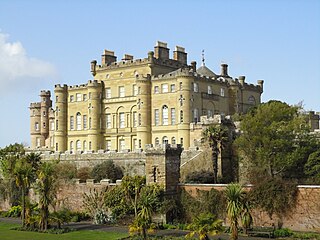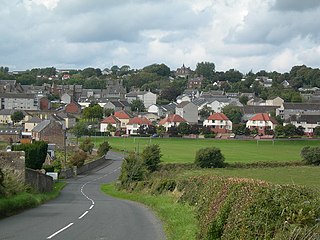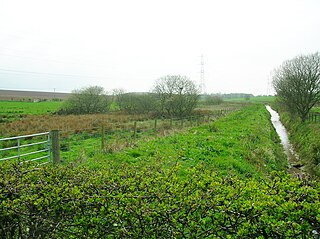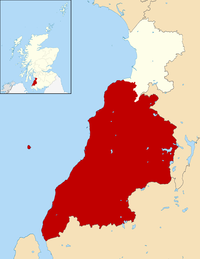
Robert Adam was a British neoclassical architect, interior designer and furniture designer. He was the son of William Adam (1689–1748), Scotland's foremost architect of the time, and trained under him. With his older brother John, Robert took on the family business, which included lucrative work for the Board of Ordnance, after William's death.

Elderslie is a village in the council area and historic county of Renfrewshire in west central Scotland. It chiefly serves as a commuter village, situated midway between the towns of Paisley and Johnstone, and lies 11 miles (18 km) west of Glasgow city centre.

Culzean Castle is a castle overlooking the Firth of Clyde, near Maybole, Carrick, in South Ayrshire, on the west coast of Scotland. It is the former home of the Marquess of Ailsa, the chief of Clan Kennedy, but is now owned by the National Trust for Scotland. The clifftop castle lies within the Culzean Castle Country Park and is opened to the public. From 1972 until 2015, an illustration of the castle was featured on the reverse side of five pound notes issued by the Royal Bank of Scotland.

Maybole is a town and former burgh of barony and police burgh in South Ayrshire, Scotland. It had an estimated population of 4,580 in 2020. It is situated 9 miles (14 km) south of Ayr and 50 miles (80 km) southwest of Glasgow by the Glasgow and South Western Railway. The town is bypassed by the A77.

Stair is a village in Ayrshire, Scotland. It lies at the bottom of a glen beside the River Ayr at the north-west border of the 5,376 acre (22 km2) Parish of Stair where the River Ayr is joined by the Glenstang Burn.

Mauchline is a town and civil parish in East Ayrshire, Scotland. In the 2001 census Mauchline had a recorded population of 4,105. It is home to the National Burns Memorial.

Agnes Broun, Agnes Brown or Agnes Burnes, was the mother of Scotland's national poet, Robert Burns. Agnes's father, Gilbert (1708–1774), was the tenant of the 300-acre (120 ha) farm of Craigenton, in Kirkoswald parish, South Ayrshire, Scotland.

Trabboch is a hamlet in East Ayrshire, Scotland. Built as a miners village in the 1880s, it was owned and leased by Wm. Baird & Co., Ltd. and at one time had 94 dwellings. The miners rows stood, until demolition in 1969, on the Stair and Littlemill road, about two miles south of Stair, in that parish. The name is locally pronounced 'Traaboch'.

Turnberry Castle is a fragmentary ruin on the coast of Kirkoswald parish, near Maybole in Ayrshire, Scotland. Situated at the extremity of the lower peninsula within the parish, it was the seat of the Earls of Carrick. Turnberry Castle is adjacent to Turnberry Golf Course.

Kirkoswald is a village and parish in the Carrick district of Ayrshire, Scotland, 1+3⁄4 miles from the coast and four miles southwest of Maybole. It takes its name from its kirk (church), dedicated to Oswald of Northumbria, who is said to have won a battle here in the 7th century. The old church, which was built in 1244 and houses the baptismal font of Robert the Bruce, is now a ruin in the grounds of the modern church, which was built in 1777 to a design by Robert Adam. Kirkoswald is also noted for its connection with Robert Burns, whose maternal ancestors, the Brouns, were from the village. Burns also attended school here, and would later base the characters Tam o' Shanter, Kirkton Jean and souter Johnnie on village locals Douglas Graham, Jean Aird and John Davidson, the shoemaker.

Closeburn is a village and civil parish in Dumfries and Galloway, Scotland. The village is on the A76 road 2+1⁄2 miles (4 km) south of Thornhill. In the 2001 census, Closeburn had a population of 1,119. Closeburn is recorded as Killosbern in 1185. The first element of the name is Gaelic cill 'cell or church'. The second element is a saint's name, but none has definitely been identified.

St. Madoes is a village in the Carse of Gowrie, Scotland. It was developed near Pitfour Castle. It is believed that there have been settlements since around 1000 C.E based on discoveries of several standing stones and the St. Madoes stone, a well-preserved Pictish cross.

Crichton Collegiate Church is situated about 0.6 miles (0.97 km) south-west of the hamlet of Crichton in Midlothian, Scotland.

The Old Calton Burial Ground is a cemetery in Edinburgh, Scotland. It located at Calton Hill to the north-east of the city centre. The burial ground was opened in 1718, and is the resting place of several notable Scots, including philosopher David Hume, scientist John Playfair, rival publishers William Blackwood and Archibald Constable, and clergyman Dr Robert Candlish. It is also the site of the Political Martyrs' Monument, an obelisk erected to the memory of a number of political reformers, and Scotland's American Civil War Memorial.

The Canongate Kirkyard stands around Canongate Kirk on the Royal Mile in Edinburgh, Scotland. The churchyard was used for burials from the late 1680s until the mid-20th century.

Hoddom is a small settlement and civil parish in Dumfries and Galloway, Scotland, dating back to the 8th century.

Seton Castle is an 18th-century Georgian castle in East Lothian, Scotland. The castle was Robert Adam's final project in Scotland.

Scipio Kennedy was a slave who was taken as a child from Guinea in West Africa. After being purchased at the age of five or six by Captain Andrew Douglas of Mains, he worked as a slave under his daughter, Jean, wife of Sir John Kennedy, 2nd Baronet of Culzean in Ayrshire, Scotland. He was granted a manumission in 1725, but continued to work for the Kennedy family and was given land on the estate. He married in 1728 and had at least eight children. At least one living descendant is known from the west of Scotland and has published the story of his ancestor in a Scottish national newspaper.




















